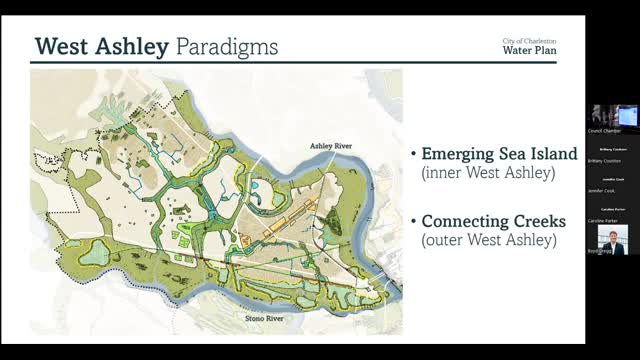West Ashley plans transformative projects to combat flooding risks
August 27, 2024 | Charleston City, Charleston County, South Carolina
This article was created by AI summarizing key points discussed. AI makes mistakes, so for full details and context, please refer to the video of the full meeting. Please report any errors so we can fix them. Report an error »

In a recent government meeting, officials outlined a comprehensive vision for the future of West Ashley, emphasizing a dual approach to urban development and environmental sustainability. The proposed plan includes the creation of a new sea island concept around the Sam Rittenberg corridor, which aims to enhance connectivity between inner and outer West Ashley through three key corridors: Savannah Highway, Glen McConnell, and Ashley River Road.
The plan highlights two major projects: the Blue Crescent and Long Branch Creek Commons. The Blue Crescent is envisioned as a Bluegreen network that will extend existing greenways and bikeways while also addressing stormwater management. This initiative seeks to transform the area into a recognizable urban corridor, akin to Atlanta's Beltline, integrating recreational paths with essential infrastructure for power, water, and sewer systems.
Long Branch Creek Commons aims to celebrate the natural marshes while providing space for community engagement. The project intends to highlight historical sites, such as an old Civil War fort, and enhance public access to waterways.
Turning to James Island, officials noted that the area faces greater storm surge risks due to its lower elevation. However, much of the infrastructure has already been adapted through FEMA programs. The discussion included strategies for marsh migration and the need for reinforcing critical connections, such as Folly Road, to maintain access as sea levels rise.
Johns Island was also addressed, with officials indicating that it experiences less storm surge exposure compared to James Island. The focus remains on managing tidal flood risks and ensuring that future developments consider the entire island, not just urban boundaries.
Overall, the meeting underscored a commitment to proactive planning that balances urban growth with environmental resilience, aiming to protect communities while enhancing their connection to nature.
The plan highlights two major projects: the Blue Crescent and Long Branch Creek Commons. The Blue Crescent is envisioned as a Bluegreen network that will extend existing greenways and bikeways while also addressing stormwater management. This initiative seeks to transform the area into a recognizable urban corridor, akin to Atlanta's Beltline, integrating recreational paths with essential infrastructure for power, water, and sewer systems.
Long Branch Creek Commons aims to celebrate the natural marshes while providing space for community engagement. The project intends to highlight historical sites, such as an old Civil War fort, and enhance public access to waterways.
Turning to James Island, officials noted that the area faces greater storm surge risks due to its lower elevation. However, much of the infrastructure has already been adapted through FEMA programs. The discussion included strategies for marsh migration and the need for reinforcing critical connections, such as Folly Road, to maintain access as sea levels rise.
Johns Island was also addressed, with officials indicating that it experiences less storm surge exposure compared to James Island. The focus remains on managing tidal flood risks and ensuring that future developments consider the entire island, not just urban boundaries.
Overall, the meeting underscored a commitment to proactive planning that balances urban growth with environmental resilience, aiming to protect communities while enhancing their connection to nature.
View full meeting
This article is based on a recent meeting—watch the full video and explore the complete transcript for deeper insights into the discussion.
View full meeting